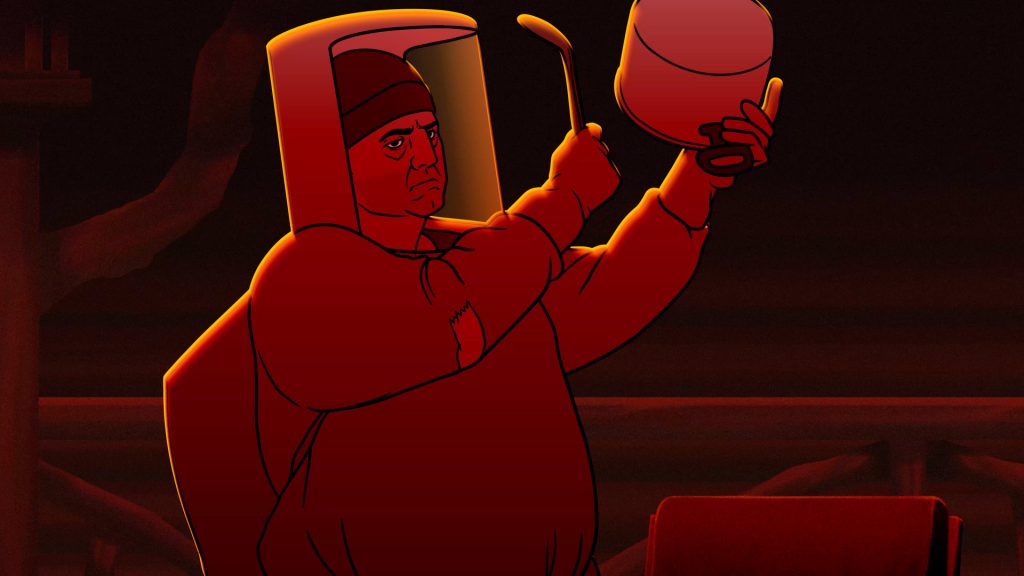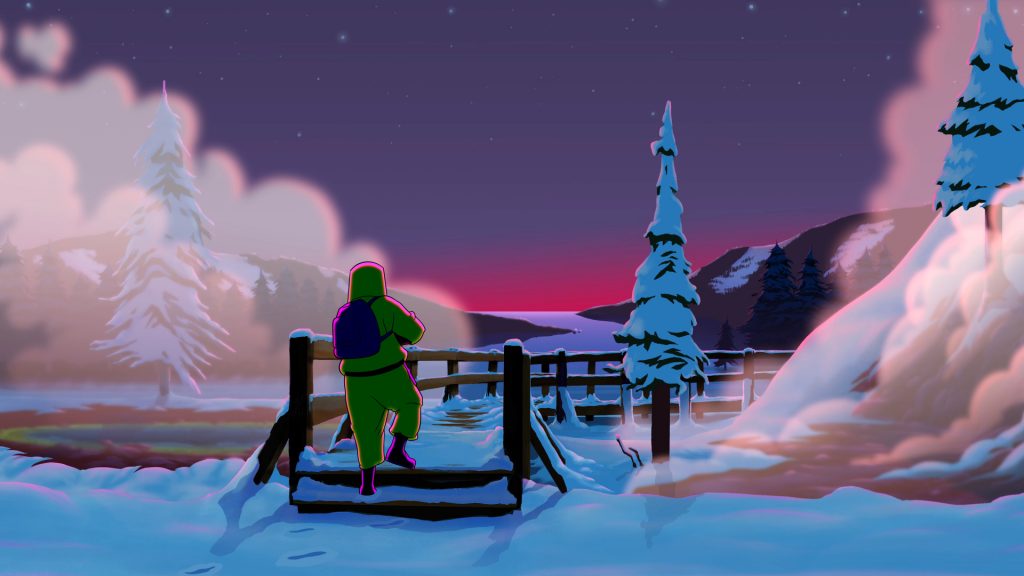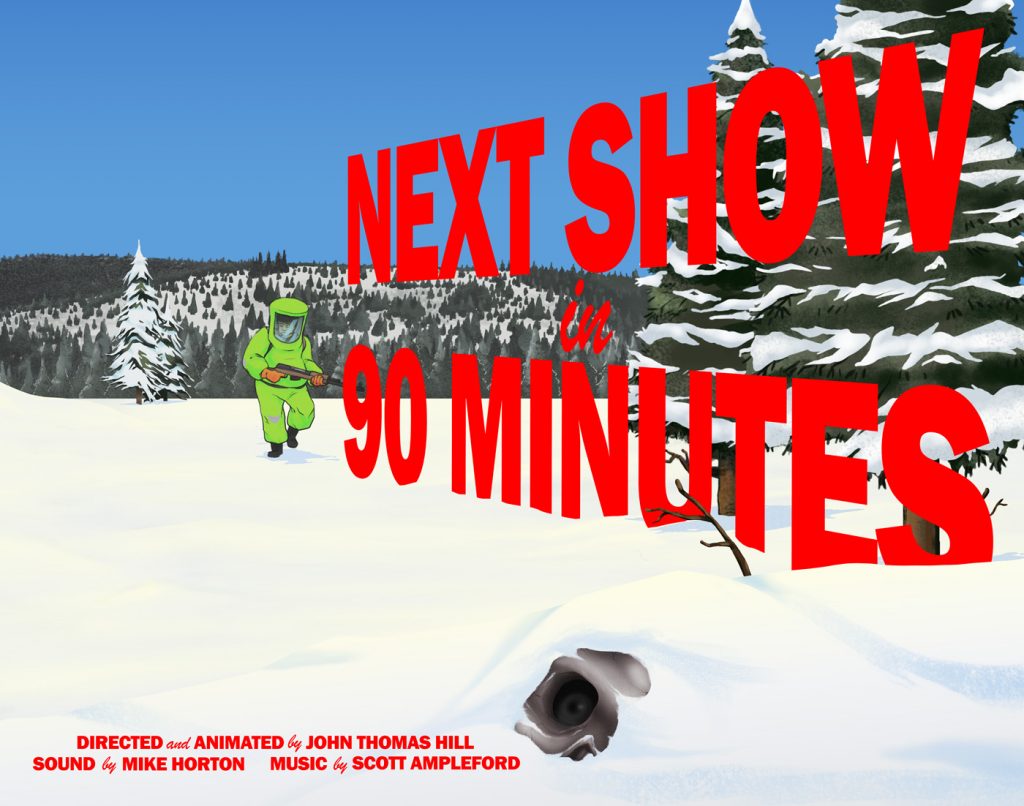Next Show in 90 Minutes is a haunting 7-minute horror film which John T. Hill directed and animated. John is a professional animator and assistant professor at the University of South Alabama who (in the light of day) teaches 2D digital character and FX animation. Inspired by classic icons of horror cinema like The Thing, John has crafted a story that explores isolation and the unknown with an intense subtlety. His efforts have earned nominations on the festival circuit from Screamfest LA , Screamfest NOLA and the Mobile Animation Film Festival.
In Next Show in 90 Minutes, John sought to evoke emotion without offering easy answers, keeping his story shrouded in mystery. His protagonist, that he simply dubbed “The Hazmat,” navigates an apocalyptic landscape. His every movement emphasizes isolation and tension with meticulous detail. The film’s vivid colour transitions — from night to day — further serve the unsettling mood. The richly textured backgrounds and complex expressions on the protagonist’s face, crafted with expert use of Toon Boom Harmony’s drawing tools, truly elevates the terror.
We spoke with John about how he was able to streamline his creative process and create immersive multiplane camera movements with Harmony. Read on for our full interview where we dive deeper into John’s process, inspirations, and the technical artistry behind this remarkable short film. Watch the atmospheric and visually striking tailer for Next Show in 90 Minutes, below…
Please introduce yourself and your animated short, Next Show in 90 Minutes…
John: I’m John T. Hill, and I’ve been in the animation industry since the early 2000’s, primarily as a 2D ‘footage’ animator on various television and multimedia productions. The majority of my career has been spent working remotely, so I’m one of the names in the credits that make most of the in-house people go “who was that?” I’m currently an Assistant Professor of Animation at the University of South Alabama. Next Show in 90 Minutes is a 7:20 minute horror short that I directed and animated independently over the last 2 1/2 years.
What are some of your main inspirations behind the spooky short?
John: Some of these questions will be tricky to answer, as I really want to avoid influencing any audience’s interpretation of the short before they’ve seen it. In fact, rereading these answers, I already feel like I’m spoiling things!
Visually there are obvious connections to John Carpenter’s The Thing, and in my mind I kept coming back to the work of Mike Ploog, William Stout, and Simon Stålenhag. In terms of the detail of the characters and expressions, I actually looked at a lot of the character sheets and keys from Alex Toth’s work at Hanna Barbera.
The scenery owes a lot to the backgrounds in Bambi and the winterscapes of Bill Watterson. Thematically my most direct inspiration was my mother and her love of the Dan O’Bannon zombie classic Return of the Living Dead. This idea, of a horror film in a naturally serene environment, was originally a small part of a much larger graphic novel idea I had in the late aughts, but all that remains from that is the image of a man in a hazmat suit and zombies in the snow.
Can you allude to what has happened to land your protagonist in his situation?
John: Nope. It’s a question I have been asked by a few of the people I’ve shown the finished film to. But I don’t really have an answer. The why and how aren’t even in my head. The character doesn’t even have a name. I just call him “The Hazmat.”
I’ve had other short films, student films, and a lot of professional experience that is very narrative driven. “Point A to B to C.” “Set up and pay off.” “Don’t leave things unanswered.” This was a chance to do, not something unorthodox or revolutionary, but just what I wanted. Only notes from me.
With Next Show in 90 Minutes I had a feeling. And I wanted to present that to an audience and just see how they reacted. I went into this wanting to elicit emotion and give no answers. So I purposefully banished any ideas I developed about what happened before or after in the universe of the film. There was a rough version of this, just bullet points, before the first storyboard, that had a lot of storytelling beats in it. None of it survived the animatic.
As an animator, how do you explore themes of isolation or apocalypse in your work?
John: This is definitely the first time I’ve explored those themes in a serious way.
There are two different kinds of moments in the film. These solitary moments in the wild, and then these moments with The Hazmat. I wanted the solitary moments to feel like a nature documentary. Keeping the camera locked down and distant to take the living human element out of it. It feels more like a trail cam.
There is always a fun feeling when you see the making of clips of nature documentaries and find out that a camera man was buried in mud for two days to get a shot. They make you feel like you’re watching something sacred and devoid of human interference, that doesn’t need us to observe them to exist. Of course, it’s really an immense human effort to capture those moments. And sometimes to even stage them so they feel so natural on film. I identified with that as the animator.
Then, with The Hazmat, we contrast those moments, the human presence is unavoidable in comparison. So the isolation is built on the framing. A lot of long shots to show the lack of other figures or characters, emphasizing emptiness. Having the wide shots meant that any close ups felt very deliberate. The contrast between voyeur distance and intimate closeness makes the emotions of the character exaggerated even when they are subtle.
The rest is pacing, being mindful of how you deploy these moments. The length of a scene, but also the length of an individual shot. I found that having a shot last longer than felt natural was something I became fascinated with. That feeling of wanting a shot to change, but denying the release creates tension, and that lack of control is isolating. Of course, this made the process very laborious, long shots with subtle movements, entire figures, lingering on moments that would otherwise be cut.

What decisions went into choosing the vivid color palette, and why?
John: Part of it was creating a sense of time, transitioning from night to sunrise then to full day. But also wanting to begin with really bold color transitions to set a tone that I would slowly strip away. The other part was just wanting to do more with color then I’ve ever attempted before. A lot of contemporary horror has embraced intense color palettes; strong pinks, purples, blues, and high contrast. So it’s a nod and a subterfuge. Get the audience feeling comfortable in what kind of horror to expect and then change and see how that feels.
Overall I wanted brighter, purer hues when possible. Horror in the day time, horror with cartoon color. I really embraced not trying to make the animation and the backgrounds exist in perfect ‘2.5D’ harmony. If elements of it have a 70s or 90s TV vibe, where you can tell something is going to move because it’s painted flat, like an old Scooby Doo cell on top of a painted background, that was my sweet spot. Part of it was just celebrating that it was a cartoon while not doing something family friendly.
What are your tips for zombified character design?
John: I wish I was an expert in that! I can tell you what I wanted, which was skeletal and meaty, and if at all possible, wet. I wanted there to be a question of how ‘fresh’ these zombies were, so finding ways to make them look decomposed one way, and not in another way just adds to a feeling of unnatural-ness. Some of these are based on real people from my life, so a reference is always helpful. Exposed teeth and gums are always scary, missing pieces of a body are always off putting.
How did Toon Boom Harmony help support your production process on this piece?
John: We use Harmony in the courses I teach, so a big part of this was trying to animate and composite the entire film in Harmony alone, so as to be ready to fully demonstrate those capabilities to my students who want to make 2D films for their theses. Only two shots required me to use another piece of software to get the effect I wanted.
The biggest thing that helped was just being able to share palettes between scenes. Being able to edit a palette on the fly and carry that over as I pushed those color changes from shot to shot was invaluable. The camera is so powerful in Harmony, I just love using it. Just setting up a multiplane with depth and pushing the camera around. I knew I wouldn’t have time to do a lot of cast shadows and bespoke shading so the ability to add gradients and highlights to do simple cheats for shadow and light was great.

Your protagonist is very expressive. How was such a detailed look achieved?
John: This is actually another thing that Harmony was perfect for. I am not a naturalistic animator. A big reason I wanted to do this film was because I wanted to animate animals and people that were more realistic than what my professional work has allowed. That was a huge challenge, and meant a lot of video references.
I actually got out in my yard, in the July heat in Mobile, AL, in my biggest winter coat, boots, gloves, and beanie, and acted out the entire ‘human’ portion of the film. Including my son and I pretending to be zombies and corpses. My wife filmed it on my phone. I then edited down all of those multiple takes into the final animatic. That’s how I nailed down the timing of the short, and cut out all those story elements that could be removed without completely collapsing the whole.
I then took that video reference and imported it right into Harmony. That allowed me to pull out poses and expressions as the keys. This wasn’t a full rotoscope, but I would take my pose and acting and draw over it, simplifying and trying to inject that Alex Toth feel (as poorly as I could!) into the keys.
Then I would just inbetween from those referenced keys as I normally would any other animation. It’s not revolutionary, but Harmony’s ability to ‘behave’ with imported video was a great advantage to getting all this footage done. I’m not a very good actor, but having a base to then exaggerate from was how I got the expressive face.
What are some core concepts you keep front of mind when animating in the horror genre?
John: Just deciding what you really think is scary and trying to adhere to that. Or if not a single thing you find scary, then at least a type of fear you’re interested in and keeping it as a guiding light. Horror is a big genre and historically what is scary and what isn’t is very broad. Is it gore? Is it body horror? Or is it violence? Supernatural? Realistic? Suspense? Jump scares? So there was a core concept I was aiming for, but I hesitate to identify it. As advice I would say to pick something and keep it in the forefront. A perverse twist on following your bliss.

Do you want to shout out any team members or contributors?
John: My son, Jack, and wife Laura. Laura was the camera for all my original reference footage, and even learned a little Harmony to help me do flat colors on several scenes while I wrapped up the animation. Scott Ampleford, who did the music, and Mike Horton who did the sound. The film wouldn’t be half as effective without their contributions, and they were both incredible to work with.
- Next Show in 90 Minutes will be screening in animation festivals worldwide. For more of John T. Hill’s work, visit his online portfolio.
- Are you ready to get started on your own independent horror film? Artists can download a free 21-day trial of Toon Boom Harmony.
The post John T. Hill on designing the horror in Next Show in 90 Minutes appeared first on Toon Boom Animation.
Courtesy: https://www.toonboom.com/john-t-hill-on-designing-the-horror-in-next-show-in-90-minutes






